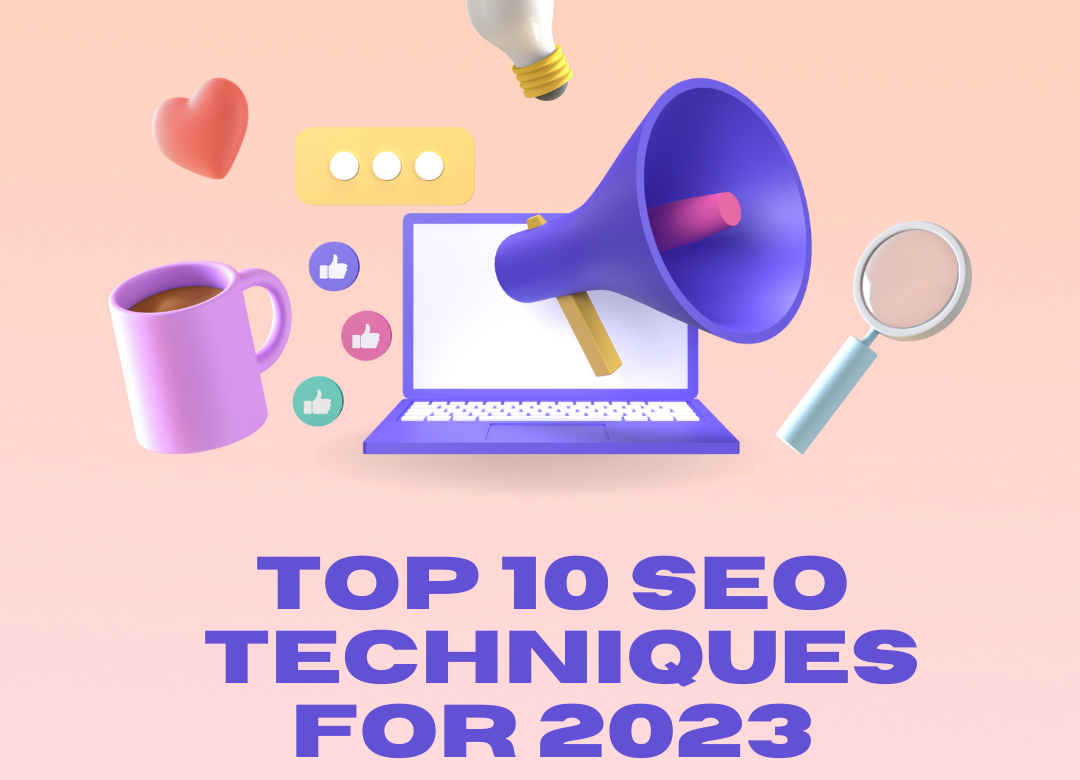Top 10 SEO Techniques For 2023

Are you frustrated with your website languishing on the second, third, or even tenth page of search engine results? Do you aspire to elevate your online presence and attract a higher volume of qualified leads? It’s time to enhance your SEO strategy! In this article, we present ten crucial techniques that will propel your website’s traffic in 2023 and beyond. From optimizing for voice search to harnessing AI-powered chatbots, we cover the most recent trends. So, prepare a beverage and join us as we explore the dynamic world of SEO!
SEO Technique #1: Augment Website Content
To increase your website’s traffic, one of the most effective steps is to enhance your content quality. Crafting well-written, informative, and keyword-rich content will not only facilitate discoverability but also encourage return visits. Here are some guidelines for augmenting your website content:
- Ensure all content is well-written and error-free. Typographical and grammatical errors can appear unprofessional and deter visitors.
- Compose captivating and unique content that engages users. Dull or generic content will not retain visitor interest.
- Strategically incorporate keywords throughout your content to assist users in finding your site via search engines. Avoid excessive use of keywords, as this can result in a spammy appearance and potential search engine penalties.
- Regularly update your content with new and pertinent information, thereby enticing users to revisit your site.
Adhering to these suggestions will significantly improve your website’s content quality and traffic.
SEO Technique #2: Optimize Title Tags and Meta Descriptions

Title tags and meta descriptions are two critical elements of on-page SEO. Title tags appear as clickable headlines in search engine results pages (SERPs), while meta descriptions provide brief text snippets beneath the title tag. Both should be optimized with relevant keywords and designed to entice users to visit your site.
Optimizing title tags and meta descriptions is crucial for two reasons: first, it assists search engines in comprehending and indexing your website; second, it convinces users of your site’s relevance to their search query. Striking the right balance between keyword-rich and user-friendly is essential.
Here are some tips for optimizing title tags and meta descriptions:
- Place relevant keywords early in your title tags to ensure your website appears in SERPs for those keywords.
- Limit your title tags to 60 characters to avoid truncation in SERPs.
- Craft unique, compelling meta descriptions that accurately represent your page content, persuading users to click through from SERPs.
- Employ actionable language in both title tags and meta descriptions, encouraging users to engage with your site.
SEO Technique #3: Target Long-Tail Keywords

One of the most effective ways to boost your website’s traffic is to target long-tail keywords. These are lengthier, more specific keywords with less competition, making them easier to rank for.
For instance, if you sell women’s shoes, a long-tail keyword might be “women’s black leather pumps size 8.” This is far more specific than “women’s shoes” or “black leather pumps,” and will be easier to rank for in search engines. Less competition means more traffic from these keywords compared to broader ones.
To identify long-tail keywords, use a keyword research tool like Google Ads Keyword Planner or Wordtracker. Input a seed keyword related to your business, and the tool will generate a list of long-tail keywords for you to target.
Once you’ve found suitable keywords, create content around them. Write blog posts, develop product pages, and build other pages on your website optimized for these keywords. The more content you have targeting each keyword, the better your chances of ranking in search engines and attracting traffic from those keywords.
SEO Technique #4: Optimize Web Pages for Mobile
With mobile devices accounting for over half of all web traffic, it’s crucial to ensure your website is optimized for mobile users. One approach is to design your web Pages with mobile devices in mind. This involves using a responsive design that automatically adjusts to the screen size of the device and ensuring your content is easily readable and navigable on smaller screens. Utilize Google’s Mobile-Friendly test to determine if your website meets their mobile-friendly criteria.
SEO Technique #5: Implement Schema Markup
Schema markup is a code you can add to your website to help search engines better understand your content. It’s a type of microdata that conveys information about your website in a structured manner.
Adding schema markup can improve your click-through rate – the number of users who click on your website link when it appears in search results. A higher click-through rate translates to more traffic.
Common schema markup types include product reviews, local business listings, event listings, and recipes. Implementing schema markup typically involves adding a few lines of code to your web pages. If coding is not your forte, numerous online resources and tools can assist you. Once you’ve implemented schema markup on your website, use Google’s Structured Data Testing Tool to verify its functionality.
SEO Technique #6: Enhance Website Load Speed

Regardless of the quality of your website’s content, slow loading speeds can cause users to abandon your site before they have a chance to engage with it. Regrettably, slow loading speeds can also negatively impact your website’s search engine ranking. To boost your website’s traffic, it’s essential to focus on improving its load speed.
Here are some strategies to achieve this:
- Use a Content Delivery Network (CDN). A CDN stores your website’s static content (such as images and videos) on servers worldwide, enabling users to access your site from the closest server, thereby increasing loading speeds.
- Optimize your images. Large image files can cause lengthy load times, so use the smallest file size possible without compromising quality. Image compression tools like TinyPNG or ImageOptim can help.
- Minimize HTTP requests. Each time a user accesses a page on your website, their browser sends an HTTP request to your server. Reducing HTTP requests can be achieved by combining multiple CSS and JavaScript files into one and using CSS sprites for images.
- Enable browser caching. This allows users’ browsers to store copies of your website’s files, reducing the need to reload the entire site during subsequent visits.
SEO Technique #7: Produce Link-Worthy Content
To fully reap the benefits of SEO, create content that other websites will want to link to, known as link-worthy content. This refers to high-quality, original content that delivers value to readers and has a high likelihood of being referenced by other websites. To generate link-worthy content, begin by brainstorming ideas valuable to your target audience. Conduct research to confirm demand for the topic. Next, create well-written, informative articles or blog posts that provide in-depth answers to commonly searched questions.
For truly link-worthy content, ensure it is visually appealing and easily digestible. Using headings, images, and lists to break up text makes it more scannable and engaging. Lastly, promote your content on social media and other websites to raise awareness and encourage others to link to it.
SEO Technique #8: Optimize for Voice Search
With the increasing popularity of voice-activated devices, optimizing your website for voice search is crucial. Voice search queries are typically longer and more conversational than typed queries. To adapt, focus on long-tail keywords and natural language patterns. Additionally, ensure your content answers common questions concisely and accurately.
SEO Technique #9: Leverage AI-Powered Chatbots
AI-powered chatbots can significantly enhance user experience by providing instant support and assistance. Integrating a chatbot into your website can help users find the information they need quickly, improving engagement and increasing the likelihood of conversion.
SEO Technique #10: Build High-Quality Backlinks
High-quality backlinks from authoritative websites signal to search engines that your website is a valuable and trustworthy source of information. Focus on creating link-worthy content and forming relationships with industry influencers and reputable websites. Guest blogging, creating shareable infographics, and engaging in relevant online communities can all contribute to earning valuable backlinks.
By implementing these ten essential SEO techniques, you’ll be well on your way to boosting your website’s traffic in 2023 and beyond. Stay up-to-date with the latest trends and best practices in SEO to maintain your online presence and attract more qualified leads. Remember that SEO is an ongoing process, and it’s essential to continually monitor and adjust your strategies as necessary to achieve long-term success. Happy optimizing!

